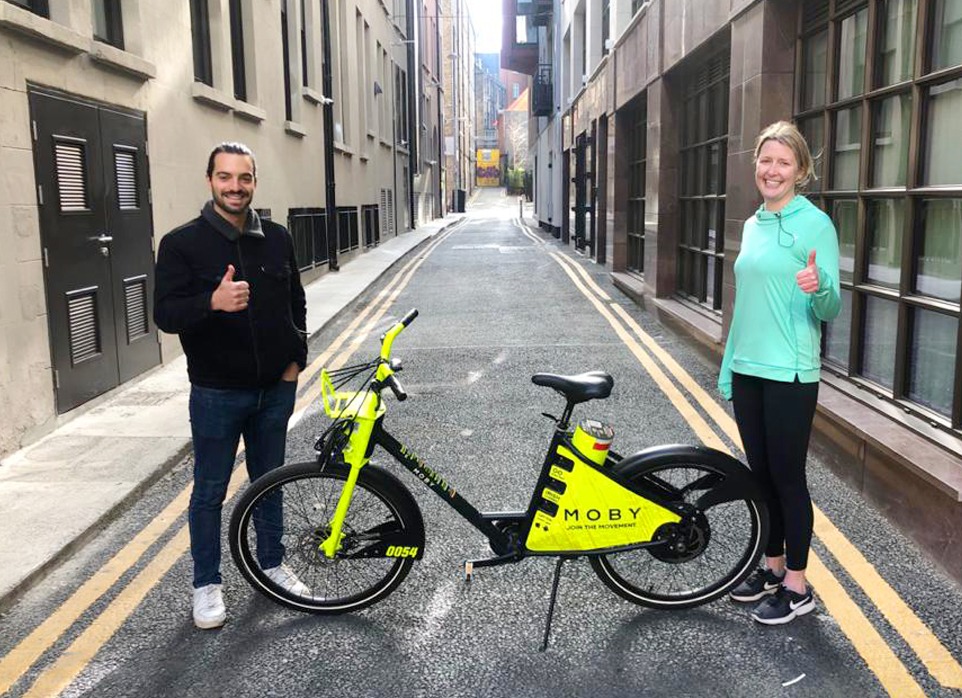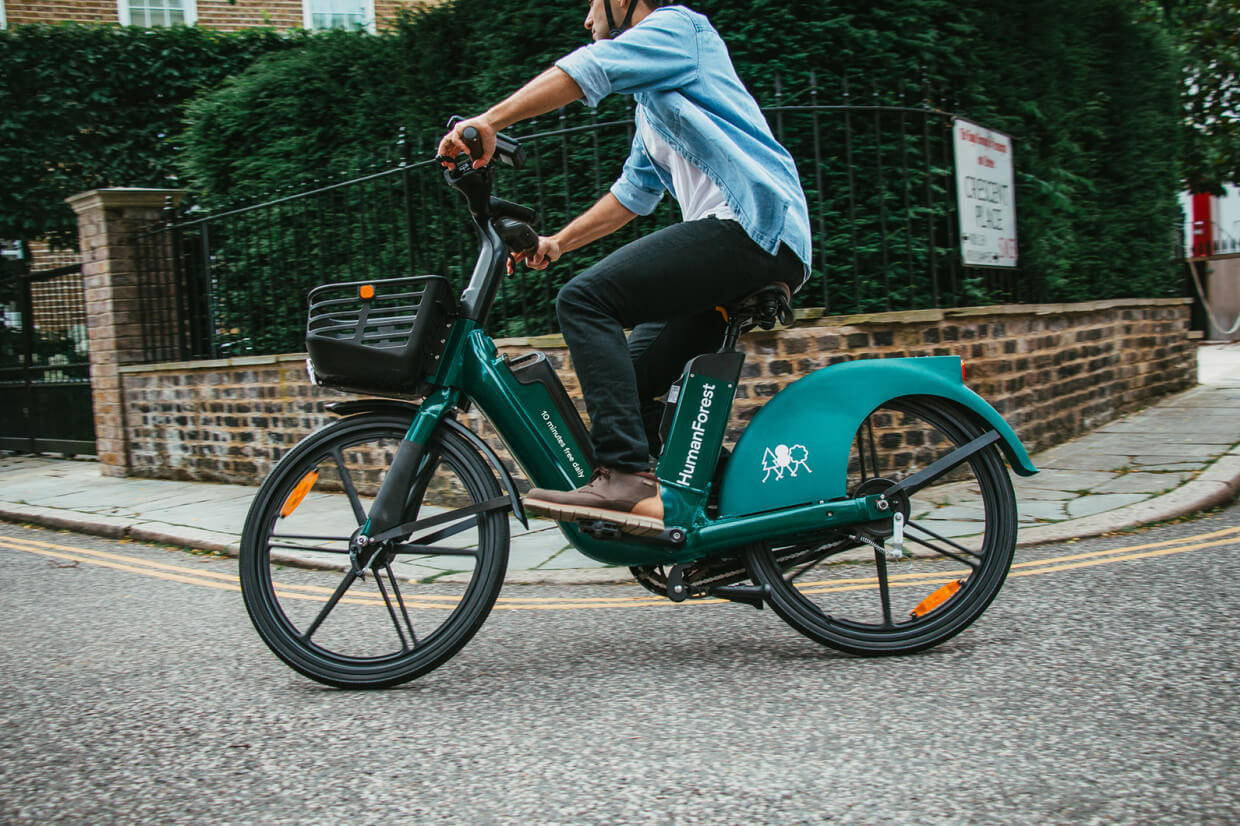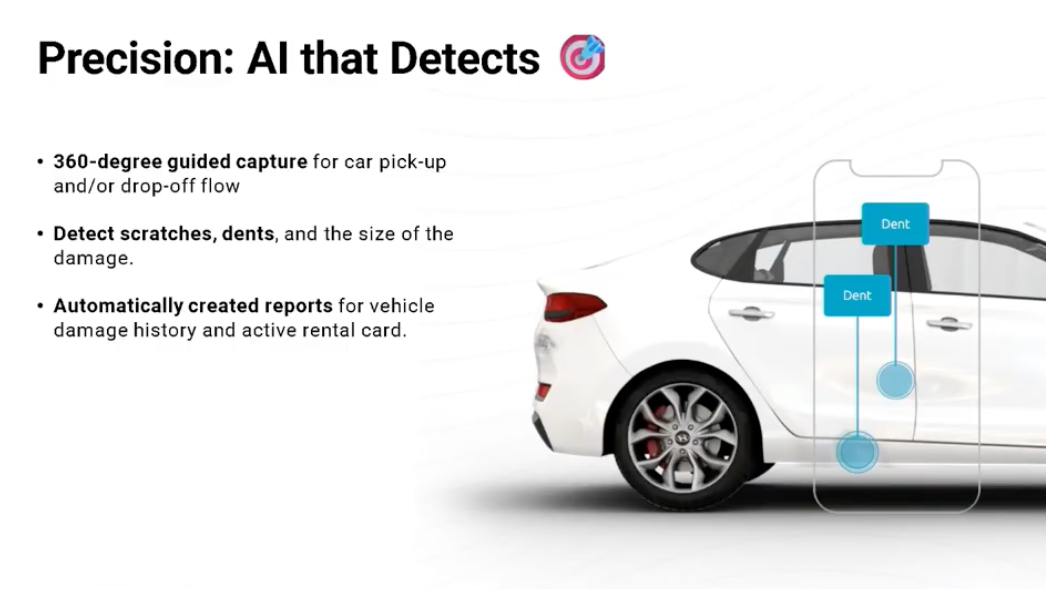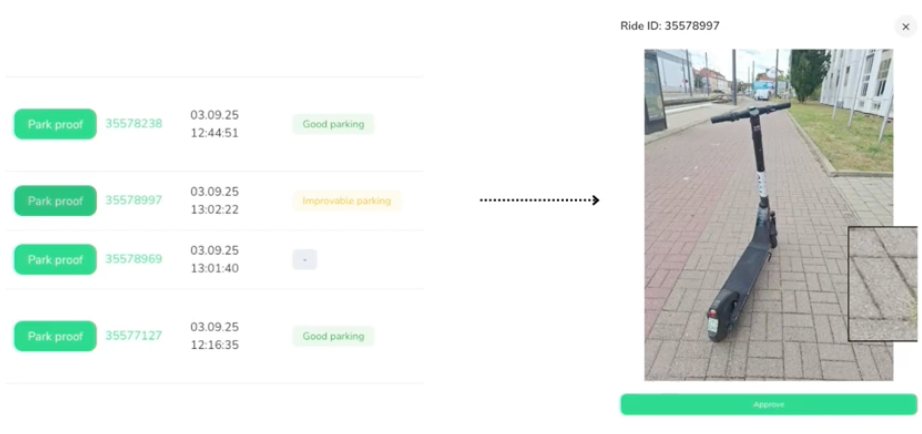
Technology is helping transform the future of urban transportation by influencing what mobility will look like, and how it will impact the modern city-scape. A recent article by Forbes Technology Council explained that there is a shared consensus around the four key features of future mobility: shared, hybrid, autonomous and electric. The next question becomes, what will mobility services will be available in the coming years? We have done some research to help breakdown the different perspectives on shared mobility as a mode of transportation in the future.
Why electric?

By 2040, electric cars will outsell gasoline-powered cars
Recently consumers have shifted their interest towards electric vehicles as a more sustainable and environmentally conscious option for long-distance travel. Predictions expect electric vehicles to surpass traditional combustion cars within the next 20 years, with 57% of passenger vehicles and more than 30% of global passenger vehicle fleet sales being electric by 2040. With this growth also comes a need for additional charging infrastructure to allow the vehicles to travel further over long distances. Currently there are about 13,000 electric vehicle fast charging stations across the US, compared to roughly 332,000 gas stations. Companies such as Volkswagon, GM and Tesla, have announced they are working on creating charging that will help drive sales in the future. Successful expansion into the market will require cities to develop smart plans that accommodate the needs of electric mobility.
Why shared?
Shared mobility has grown extensively since Uber (2009) and Lyft (2012) first entered the market. More and more operators continue to emerge worldwide, offering at least one ridesharing service to people in over 700 cities. These services are expected to expand even further in the future as a result of increased urbanization, as well as growing concerns around sustainability, economic stability and emissions. A report by the Internet of Things’ analyst firm, Berg Insights, found the number of car-sharing service users will grow from 50.4 million people in 2018 to 227.1 million people in 2023. Offering mobility as a service is helping reduce the number of single-use vehicles on the road, lending itself to a more functional form of travel.
Why autonomous?
A major challenge facing urban drivers is the issue of congestion and traffic jams. In some metropolitan cities, such as London, the problem lead to the enforcement of congestion charges in their most heavily populated neighbourhoods. In effect since 2003, these charges have helped reduce traffic by 30%, will simultaneously generating funds for the city. But is that enough? Autonomous vehicles are believed to be the next step in reducing congestion. A study conducted by researchers at the University of Cambridge found that when a fleet of autonomous vehicles are effectively communicating, keeping traffic moving smoothly, congestion rates could be reduced by 35%.
Why hybrid?
Micro-mobility is the use of small mobility devices, designed to carry one or two people, or ‘last-mile’ deliveries. This goes hand-in-hand with the rising interest in e-scooters and e-bikes that have seen exceptional sales growth in recent years. The combination of electric with single-use, lightweight vehicles is expected to surpass traditional modes of transportation. In their annual technology, media and telecommunications predictions, Deloitte predicted more than 130 million e-bikes will be sold between 2020 and 2023. Compared to the 1.8 million sold in Europe and 185,000 in the US during 2013, this significant increase suggests that e-bikes and other technology like it are the future of mobility.
How are city’s supporting?
Cities across the world have begun adapting strategies to assist with the future of urban mobility. Being the leader in reducing traffic, Singapore introduced Area licencing Scheme in 1975, enforcing a daily toll charge of $3 or $60 monthly for cars entering a central zone area during peak hours. The city experienced success resulting in fewer cars entering the zone during peak hours, a 35 percent increase in carpools and a minimum of $500 million saved by the city that could be used towards infrastructure improvements. The system has since been updated to an Electrical Road Pricing system in order to match the changing demands of the city’s core.
San Francisco has yet to enforce congestion pricing for its traffic heavy neighbourhoods, however, research is being conducted to determine the best solutions for the city. The Emerging Mobility Evaluation Report by the San Francisco Transportation Authority found 90 percent of all motor vehicle collisions are caused by human error, with approximately 80 percent involving some level of inattention. This has lead to a shift towards alternative modes of mobility and potential pilot projects within the city core. San Francisco has become known for its low income bike share programs. Launching in 2013 the Bay Area Bike Share Pilot requires at least 20% of stations be located in low-income communities, with an estimated 320 stations and 4,500 in 2017. Data collected by the Bike-sharing Blog estimates there are twice as many bike-sharing programs in the world as there were in 2014, with nearly 20 times more bikes available for public use.
The doors have opened for industry leaders to start making innovations within auto-mobility, influencing the modern city-scape. In addition to placing restrictions on heavily congested areas, the city of Helsinki has focused its efforts on improving the existing infrastructure and transportation options to encourage people to utilize other modes of mobility. A leader in mobility-as-a-service (MaaS) platforms, the city plans to replace 2.3 billion urban private car journeys annually by 2023. One of the ways it’s begun to accomplish this is through the app Whim. An app developed specifically for Helsinki, Whim provides access to all of the city’s mobility options through a monthly subscription. The future of mobility is at people’s fingertips.
What’s next?
Cities around the world are beginning to explore the possibilities of e-scooters as a means to travel short distances too far to comfortably walk, as well as a potential solution towards reducing the reliance on cars. The city of Tallahassee launched a pilot program in partnership with five major e-scooter companies: Bird, Lime, VeoRide, Spin and Gotch. The purpose is to determine solutions for the major problems being faced, but to also help develop good ridership habits. The companies deployed 200 e-scooters, each capable of travelling 15 mph, under new legislation that allows them to be treated the same as bicycles. With the success of programs such as this, and companies making pledging to maintain social responsibility for user safety, e-scooters as a primary mode of mobility are on the rise.
Nuro, a self-driving start-up, is one of the few companies to currently have a fleet of fully driverless vehicles operating on public roads. In February 2019, the company secured roughly $1 billion in additional funding from SoftBank allowing them to partner with the grocery-store chain Kroeger’s for a pilot project. The pilot service has been delivering groceries in Houston, Texas since March 2019, with expansions to include other goods like Domino's Pizza and Walmart products. As of right now the fleet stands at about 75 vehicles, with plans to go public in 2020. By introducing fully automated vehicles into the market, the number of people on the road will be reduced, optimizing efficiency and offering greater protection from potential collisions or incidents.

Nuro self-driving vehicle
In addition to reducing traffic in major cities, mobility companies are also focusing their resources on addressing concerns of energy consumption and emissions. The smart scooter mobility company, Gogoro, aims to leverage the power of technology in order to change the way technology is consumed and transform how cities operate to improve sustainability. Their first fleet of smart scooters launched in 2015, delivering a high performance electric riding experience to uses in Taiwan. The company also established a network known as the Gogoro Energy Network in Taipei offers more than 1,581 battery swap stations and supports over 199,478 battery exchanges every day. In Europe, a fleet of 3,500 emissionless smart scooters were released across three major countries in 2018, helping reduce CO2 emissions by 123,655 tons and displacing more than 58,731,863 liters of gasoline. By leveraging technological progress and innovations in modern infrastructure, Gogoro is becoming a leader in transportation solutions.

Electric scooter Gogoro with swappable batteries
Companies, like Tortoise, are looking to expand the capabilities of scooters even further by introducing fleets that can move autonomously across a city and reposition themselves, without a rider. The goal is to tackle the biggest challenge currently facing operators: relocating scooters. Tortoise plans to use autonomous technology combined with teleoperation to reposition and rebalance dockless, shared e-scooters in cities. The initial deployment will include between 50 to 100 scooters per operator in each market with the intention to equip every fleet with the ability to autonomously reposition themselves. Autonomous micro-mobility like e-scooters and e-bikes are believed to be the start for creating smarter, more technologically advanced cities.
How can we help?
As both industry leaders and cities around the world are finding new ways to support the rising trend of micro-mobility, we at ATOM Mobility want to help entrepreneurs looking to enter the market. We believe that shared mobility is the future of transportation, offering assistance with integrating industry-leading vehicles ready for shared mobility, including kick scooters, scooters, bikes, mopeds, cars and more. Our customers have an excellent grasp on the current needs of local markets, and we allow them to focus on marketing and operations, while taking care of the technology.
Sources:
https://www.bbc.com/news/technology-33183031
https://www.corporateknights.com/channels/transportation/sharing-road-canadian-cities-driving-progress-shared-mobility-15593076/
https://www.forbes.com/sites/forbestechcouncil/2019/11/22/four-keys-to-future-mobility-shared-hybrid-integrated-and-electric/#3feea979339d
https://edition.cnn.com/2019/07/18/cars/electric-car-market-sales/index.html
https://about.bnef.com/electric-vehicle-outlook/
https://www.businessinsider.com/ubers-history#june-2016-kalanick-proclaims-that-uber-was-profitable-in-hundreds-of-cities-globally-but-that-the-money-was-being-reinvested-in-its-war-against-chinese-rival-didi-the-company-said-at-the-time-that-it-was-losing-1-billion-each-year-in-its-fight-against-didi-34
https://www.cnbc.com/2019/11/08/top-ride-sharing-apps-in-europe-asia-south-america-africa-and-usa.html
https://iotbusinessnews.com/2019/11/14/60333-the-public-carsharing-fleet-reached-332000-vehicles-worldwide-in-2018/
https://www.bbc.com/news/world-us-canada-47874725
https://www.sciencedaily.com/releases/2019/05/190519191641.htm
https://assets.publishing.service.gov.uk/government/uploads/system/uploads/attachment_data/file/846593/future-of-mobility-strategy.pdf
https://www2.deloitte.com/content/dam/insights/us/articles/722835_tmt-predictions-2020/DI_TMT-Prediction-2020.pdf
https://eresources.nlb.gov.sg/infopedia/articles/SIP_777_2004-12-13.html
https://eresources.nlb.gov.sg/infopedia/articles/SIP_832__2009-01-05.html
http://sfcta.org/sites/default/files/2019-03/Emerging%20Mobility%20Studies_11.pdf
https://www.sfmta.com/getting-around/bike/bike-share
https://www.businessinsider.com/bike-sharing-programs-doubled-since-2014-public-bikes-charts-2018-7?IR=T
https://www.smartcitiesworld.net/news/news/helsinki-leads-in-mobility-as-a-service-3308
https://whimapp.com/
https://eu.tallahassee.com/story/news/2019/07/15/electric-scooters-tallahassee-florida-bird-scooters-rental-gotcha-lime-spin-veoride-escooters/1708270001/
https://www.wctv.tv/content/news/Five-companies-launch-e-scooters-in-Tallahassee-during-pilot-program-512748851.html
https://nuro.ai/product
https://www.wired.com/story/softbank-nuro-self-driving-investment/
https://qz.com/1644476/nuro-will-deliver-dominos-pizza-with-its-robots-in-houston/
https://www.theverge.com/2019/12/10/21004678/nuros-driverless-delivery-robots-walmart-houston
https://medium.com/nuro/new-rules-of-the-road-for-california-and-autonomous-vehicles-2fa26a1159cb
https://www.gogoro.com/about/
https://www.tortoise.dev/
https://www.theverge.com/2019/10/15/20910083/tortoise-autonomous-electric-scooters-self-driving-robotics
https://www.fastcompany.com/90417611/it-was-inevitable-the-scooters-are-now-driving-themselves
Click below to learn more or request a demo.

🚗📲 Whether you're renting out cars, bikes or scooters, the best rental businesses in 2025 are fully digital. No more paper contracts or office keys – just tap, unlock, and go. In our latest article, we explore top apps (like Donkey Republic, MOBY Bikes and Forest) that show what a modern rental experience looks like. Plus, we explain where a full platform like ATOM Mobility fits in when you're ready to scale.
Running a rental or sharing business today means delivering a smooth, digital-first experience. Whether you rent cars, bikes, scooters or other vehicles – users expect to book online, pay, verify identity if needed, unlock a vehicle, and ride or drive without extra friction.
To make that happen reliably, you need good vehicle rental software or platform backing your service. Below are some successful examples of apps and platforms that show how this works and what is possible.
Donkey Republic
Operates in several European cities offering shared bikes and e‑bikes. Users find a bike in the app, unlock it with a smartphone, ride, then park at a designated drop‑off spot and end the rental. Pay‑as‑you‑go, daily rates or memberships are all handled via the app.
MOBY Bikes
Targets electric bicycles and e‑cargo bikes across certain regions, with a “tap‑and‑ride” system that uses its proprietary app for booking, unlocking, and rental management. The platform supports mixed-use fleets (shared bikes, cargo bikes, delivery fleet, even B2B rentals), which illustrates flexibility – useful for operators exploring different business models beyond simple consumer rentals.

Forest
It is a dockless e‑bike sharing operator in London. It runs a large fleet and offers bike‑sharing through a mobile app. The service demonstrates how a relatively simple, dockless rental model can scale at urban level using app‑based rentals, unlocking, and flexible parking.

These examples show how micromobility‑focused services already rely on booking, payment, unlocking and fleet management tech – the same core capabilities needed by any modern vehicle rental business.
What makes these apps work – and what to borrow from them
From these operators you can observe several useful traits that a good rental/sharing software should provide:
- Seamless user journey: crate account in seconds → search → book → unlock → ride/drive → return. Users don’t need paper contracts or to meet staff to get a vehicle.
- Flexible pricing & rental models: per-minute, hourly, daily, subscription, memberships – enables both occasional users and frequent commuters.
- Smart access control and vehicle tracking: unlocking via app or smart lock, GPS tracking, drop‑off in defined zones or docking stations, helps maintain order, reduce theft, and support dockless models.
- Support for different vehicle types: from bikes to e‑bikes and cargo bikes – showing that underlying software can be agnostic to vehicle type, useful if you plan a mixed fleet.
- Scalable fleet operations and maintenance: availability updates, booking history, maintenance logs, geofencing or parking zones – these help manage many vehicles across zones without chaos.
These are exactly the kinds of features you need when you move from small‑scale operation to proper fleet business.
Why to choose ATOM Mobility
If you plan to just test the market or to operate a larger and more complex fleet - multiple vehicle types, multiple cities, or advanced operational requirements - a full-stack platform like ATOM Mobility becomes essential.
ATOM Mobility is designed for operators who need full control over the entire mobility operation: booking flows, unlocking logic, payments, KYC/ID verification, backend administration, fleet analytics, dynamic pricing, and multi-modal rentals across cars, scooters, bikes, and more.
The platform provides a unified backend that supports cars, scooters, e-bikes, mopeds, and additional vehicle types within a single system. Operators can manage bookings, payments, users, smart locks or connected vehicles, fleet health, and city-level scaling without fragmenting their tech stack as the business grows.
This approach offers far greater flexibility than single-vehicle or bike-only solutions and removes the need to migrate systems when expanding into new vehicle categories or markets. Check out the full service here.
How to choose: when to use franchising vs full platform
Join a franchising when you:
- prefer operating under an established brand
- value a clear operational playbook and central support
- want simpler marketing thanks to brand recognition
- are comfortable with limited control over technology and product decisions
- accept franchise fees or revenue sharing in exchange for convenience
- don’t need heavy customization or experimentation
Use a full platform (like ATOM Mobility) when you:
- aim to manage a larger, mixed fleet (cars, scooters, bikes, e-bikes)
- need full backend control (admin, analytics, pricing, reporting)
- require payments, KYC/ID verification, and automation built in
- want freedom to customize booking flows, pricing, and partnerships
- plan to scale across cities or add new vehicle types over time
- prioritise brand ownership and customer relationship control
- want no revenue sharing or franchise fees
There isn’t a one‑size‑fits‑all solution
For simple bike or e-bike fleets, the technology barrier is already low. Joining a franchise can be a fast way to get operations running with minimal setup.
However, operators with long-term ambitions - expanding into multiple vehicle types, scaling across locations, or maintaining consistent service quality - typically outgrow narrow tools. In those cases, a full-stack platform like ATOM Mobility offers the flexibility and control needed to support growth without rebuilding the tech foundation later.
Some operators start small and migrate as complexity increases. Others choose to build on a full platform from day one to avoid future transitions. The right choice depends on how clearly you define your growth path, desired level of control, and operational complexity from the start.

📱AI in shared mobility isn’t a future trend – it’s already here, and for good. From detecting car damage to forecasting demand and verifying parking in real time, operators are using AI to reduce manual work and run more efficient fleets. In this new article, we break down 3 real use cases already live on the ATOM Mobility platform: 👁️ Vision AI, 🔍 Precision AI, 📊 Prediction AI. See how AI is changing shared mobility, and how you can start using it now.
Artificial intelligence is no longer just a trend in mobility. For modern vehicle sharing and rental services, AI is already solving real operational problems and unlocking new ways to grow. At ATOM Mobility, several AI-powered features have already been implemented into live products and tested by operators across Europe.

This article shares three real-world AI use cases that are already helping operators reduce manual work, improve asset control, and better match vehicle availability to demand.
1. Vision AI: Camera-based parking control for micromobility
Micromobility parking continues to be a challenge in cities where dockless vehicles can end up blocking sidewalks, crossings or entrances. Manual checks are costly and often too slow to solve the problem in real time.
ATOM Mobility now uses computer vision to solve this. With Vision AI, riders take a photo when ending their ride. The system analyses the image using a neural network to understand if the vehicle is parked correctly – within a designated zone and without creating obstructions. If not, the app notifies the user and prevents trip completion until the parking is corrected.Each parking photo is automatically tagged as “Good parking”, “Improvable parking” (the user receives guidance on how to improve the parking), or “Bad parking” (the user is asked to re-park).
If the user fails to submit a “Good parking” photo after several attempts, the system will accept the photo with its current tag (“Improvable” or “Bad parking”) and flag it in the dashboard for further customer support review.
This solution has been live with many operators already. It helps reduce complaints, improve compliance with city regulations, and lowers the need for manual reviews.

2. Precision AI: Detecting car rental damages with cameras and machine learning
In traditional car rental, damage inspection is slow, manual, and often inconsistent. With self-service rentals becoming more popular, operators need a smarter and faster way to verify a vehicle’s condition between trips.
ATOM Mobility has integrated AI-powered damage detection using computer vision. Customers scan the vehicle at pick-up and drop-off. The app compares images and flags scratches, dents, or other visible damage with high accuracy. This allows operators to quickly assess responsibility and reduce disputes.
The system helps protect the fleet, lowers repair costs, and adds trust for both users and operators. It’s especially useful for car sharing and self-service rental models where physical handovers are skipped.
3. Prediction AI: Forecasting demand and automating vehicle relocation
One of the biggest cost factors in shared mobility is rebalancing the fleet. If scooters or cars are idle in the wrong location, revenue is lost. At the same time, relocating vehicles manually is expensive and not always efficient.
ATOM’s AI models use historical trip data, usage trends and contextual signals (such as day of the week or weather) to forecast demand and suggest the best relocation zones. This gives operators a map of where and when to move vehicles – improving utilisation and saving time.
The system can even be combined with automated relocation logic, where users are incentivised to park in high-demand areas. This shifts part of the rebalancing cost from operators to riders and keeps the fleet productive.
Why this matters now
AI tools are finally reaching the stage where they can operate reliably, even in complex environments like cities. These examples are not abstract ideas or lab tests. They’re active features helping ourcustomers run leaner, smarter fleets today.
For micromobility operators, Vision AI reduces complaints and ensures regulatory compliance. For car rental providers, Precision AI saves hours of staff time and improves trust. And for both, Prediction AI improves margins by making sure vehicles are where users need them.
What’s up next?
These are just the first steps. AI in mobility will continue to expand with smarter pricing engines, voice-based support, predictive maintenance, and more. But the examples above already prove that even small AI integrations can bring major improvements.
At ATOM Mobility, we continue building these tools directly into our platform so that operators don’t need to develop them in-house. If you want to see how these AI-powered features work in action, get in touch with our team.
AI in shared mobility is not about replacing people. It’s about giving operators better tools to run faster, smarter, and more efficient services.


